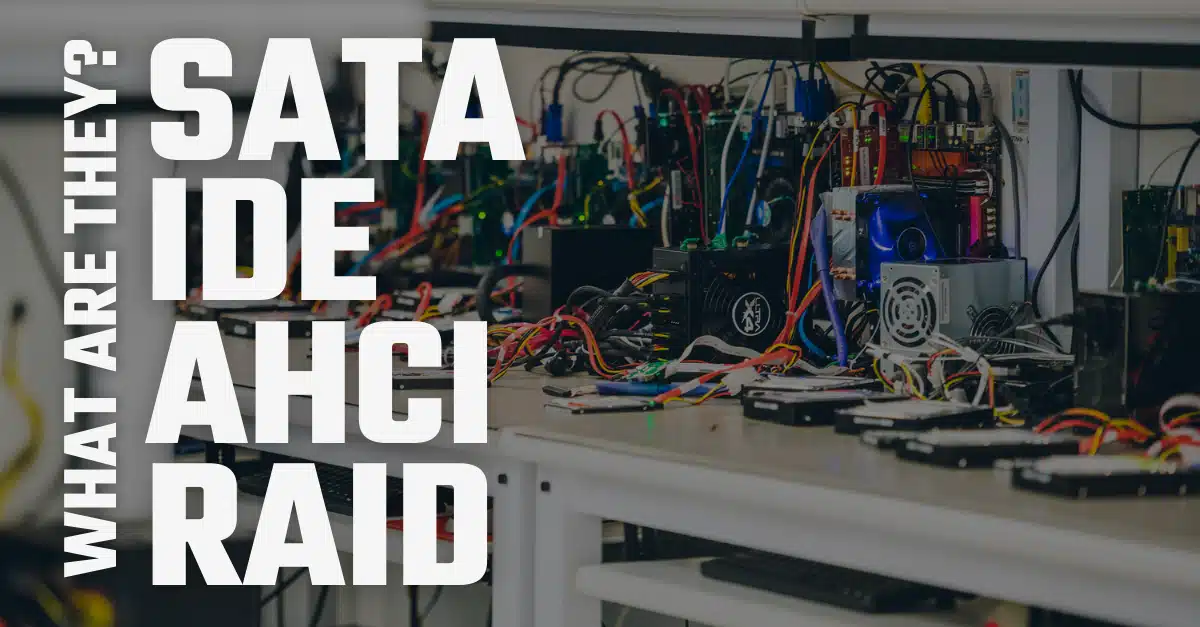When it comes to your external hard disk drive or solid-state drive (SSD), dealing with constant disconnecting issues can be equally annoying, particularly when you’re trying to access important data.
What is SATA, IDE, AHCI and RAID?

Hard drives are one of the most important parts of our computers and smart devices. These components are where our most precious memories and valued information live. Understanding how hard drives work is key to properly maintaining them for functionality and longevity.
But learning how a hard drive works is no small undertaking. There are multiple components, protocols, and programs constantly working together so you can read and write data whenever you need to.
Although challenging, becoming familiar with concepts like AHCI vs. RAID and IDE vs. SATA can help maintain your hard drive’s peak performance for as long as possible.
What is SATA?
SATA stands for Serial Advanced Technology Attachment. SATA is how a storage unit, like a hard drive, connects to the motherboard. SATA connections transfer data using a serial link cable to form a point-to-point connection between the storage device and motherboard.
This technology, developed in 2003, is found in many computers, laptops and servers. But in recent years, some manufacturers have abandoned SATA technology in favor of drives with higher speeds. Still, this technology holds up with solid transmission speeds and excellent storage capacities.
What is IDE?
IDE stands for Integrated Drive Electronics. IDE is a type of Peripheral Component Interconnect (PCI) device used to transport data from a storage device to the SATA controllers. This technology, also called Parallel ATA, was developed by Western Digital in 1986.
IDE was in many computers throughout the late 1980s and 1990s and is the predecessor of SATA. IDEs are known for their high level of compatibility. You can use an IDE with nearly any type of system.
But because of the technology’s age, IDE has limitations in modern computing and has become obsolete. Western Digital and Seagate stopped manufacturing IDEs in 2013.
What is AHCI?
AHCI stands for Advanced Host Controller Interface. AHCI is a type of PCI used to move data from a hard drive to SATA controllers. Think of AHCI as a bus going back and forth between the host and the SATA controllers on the motherboard.
AHCI was developed in 2004 to replace IDE interfaces. This system is superior because of the improved storage management features and ability to hot-swap drives. On the other hand, AHCI mode limits speed because it can only hold 32 input/output requests in the queue.
What is RAID?
RAID stands for Redundant Array of Independent Disks. This storage technology works by combining the storage and computing power of several separate hard drives. In a RAID configuration, any number of hard drives with the same storage capacity can be connected to function as one.
RAID technology offers excellent data protection and resilience because it can continue operating even if a drive in the array fails. A RAID configuration can be added with hardware or software.
How do these systems compare?
The endless acronyms and nuances of hard drive technology can be difficult to grasp. Check out these comparisons to learn how SATA, IDE, AHCI, and RAID are both alike and different.
AHCI vs. RAID
AHCI transports data from a drive to a motherboard while RAID organizes several hard drives into a single storage unit. So, in theory, AHCI could transport information from a RAID array to the motherboard. But these components aren’t in competition with each other, because they don’t function in the same way.
IDE vs. SATA
Both IDE and SATA provide a means for information to travel from the hard drive to the motherboard. As mentioned above, SATA replaced IDE in the early 2000s due to the faster pace and increased capacity available. Today IDE is only used in very old applications, and SATA is quite common in modern devices.
ATA vs. AHCI
Much like IDE vs. SATA, comparing ATA vs. AHCI is really a matter of age. ATA is used in IDE configurations, while AHCI is the mode of information transport used in SATA configurations.
AHCI vs. IDE
Since AHCI and IDE don’t fulfill the same role, we can’t compare them. IDE is an antiquated means of data transfer association with ATA, while ACHI is the bus used in SATA data transfer configurations.
Each of these configurations does have one very important aspect in common. And that’s their potential ability to fail! If your RAID, SATA or IDE fails, you need a qualified data recovery professional. We can help with all your data storage needs. Contact DriveSavers today to get started!




